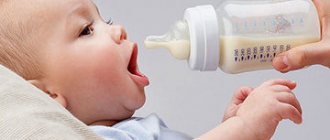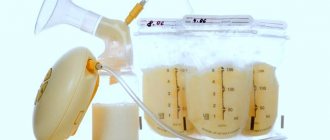Mixed feeding: what is it?
Mixed feeding is the organization of a newborn’s diet, which combines breast and artificial feeding. The mother feeds the baby both breast and formula. With the correct introduction of supplementary feeding, the baby gains weight well and receives all the necessary minerals and vitamins for normal development.
The reasons for introducing mixed feeding may vary. But basically, this is a lack of mother's milk. How can you tell if a child is malnourished? On the Internet you can find a lot of recommendations on this matter - for example, assessing the color of your baby’s urine. But in this matter it is better to trust your pediatrician! Only a doctor, taking into account the child’s weight gain and his behavior, will be able to draw the right conclusions. And if necessary, he will recommend that the mother introduce supplementary feeding into the newborn’s diet. The fact is that the reasons for poor weight gain in babies are different, it’s not just a lack of breast milk.
Among the other most common reasons for introducing mixed feeding are periodic absences of the mother. If a woman cannot breastfeed her baby, this feeding is replaced with formula.
Sometimes a sufficient reason for introducing an artificial formula into the diet of a newborn is the baby's frequent regurgitation, constipation and colic. But in most cases, all this is “treated” with probiotics for the child and a diet for the mother. In this case, breastfeeding is still quite possible to fight for.
There is an opinion that the introduction of supplementary feeding has a negative impact on the development of the child’s immunity and the functioning of his digestive system. This is actually a myth. Yes, there is nothing healthier than breast milk for a newborn. But a good, correctly selected mixture will definitely not make him any worse.
On the contrary, mixed feeding allows the mother to maintain lactation at the proper level and does not give cause for concern that the baby is not receiving vital nutrients.
How to maintain lactation if the mother cannot be with the child all day?
Sometimes a mother who has returned to work or is taking strong medications is forced to switch to mixed feeding. Reviews from women who have gone this route indicate that even at work or while taking medications, you can maintain lactation by regularly expressing breast milk using a breast pump.
If hygienic conditions are observed, this milk can be placed in a cooler bag and frozen at home or given to the child later from a bottle (except in cases of taking medications, of course).
In sad situations, when the baby is in the hospital isolated from the mother, who is deprived of the opportunity to breastfeed, this method will not only help maintain lactation, but also, by agreement with the doctor, will contribute to a speedy recovery of the baby, for whom mother’s milk will become a medicine.
How to organize mixed feeding
Supplementing your baby with formula is done in several ways:
- the mother gives the baby a little mixture after breastfeeding;
- the mother completely replaces one or more breastfeedings with formula.
Doctors recommend this option of mixed feeding, when the mixture is only an addition to mother's milk, and not a complete replacement for one of the feedings for the baby. But the decision, of course, will depend on how well the newborn is gaining weight. It is quite possible that he does not need formula at all, and the mother should try to put the baby to the breast more often to stimulate lactation.
What rules should be followed when introducing supplementary feeding in the form of mixtures into a baby’s diet?
A balanced decision on the introduction of formulas into baby food
Many mothers introduce artificial formulas into their baby’s diet while still in the maternity hospital. This is sometimes recommended by doctors, since women have “unstable” lactation in the first days and even weeks after the birth of a child. There is a risk that the baby will lose weight. And mom is in a panic stocking up on boxes of formula. Take your time.
In fact, a slight loss of weight in a baby immediately after birth is a normal situation. Next week he will definitely make up for the “deficit” of grams. In the first days after birth, it is important to put the baby to the breast more often in order to establish lactation. You may not need the mixture at all.
But it is possible to draw any conclusions about the lack of mother’s milk only a few weeks after the birth of the child. But by this time, children are usually already actively gaining weight - of course, in the absence of digestive problems, such as lactase deficiency. This is why you need to consult a pediatrician - diseases whose symptoms include “underweight” should be excluded.
Smooth introduction of artificial mixtures
If the doctor recommends switching the baby to mixed feeding, the mixture should be introduced gradually. Not a full bottle at once, but a very small amount. It is important to make sure that the child “accepts” the new product well - without stomach cramps or allergies.
In general, this is a standard rule for mothers, which should be used in the future when introducing complementary foods in the form of cereals and vegetables. First, small portions of the new product, and then gradually increasing them.
Formula only after breast milk
If mixed feeding is not the goal of a complete transition to formula, it is extremely important to try to maintain lactation. To do this, doctors recommend first placing the newborn on both breasts, and only then giving him formula.
In the case of infants, supplementary feeding is administered through a bottle with a nipple. It is convenient if the mixture makes up about 40-50% of the daily diet. Older children (3-4 months) can be given supplementary feeding from a spoon - but it will only work if the proportion of the formula in the baby’s diet is small.
Calculation of the amount of supplementary feeding
Mixed feeding of an infant is organized in accordance with the calculation of the amount of milk formula. If, as a result of the “wet test,” only 7 diapers were wet instead of the required 12, then the supplemental feeding received should be exactly enough to wet 5 more diapers.
For a child up to three months, each act of urination requires approximately 30 ml of nutrition. Five dry diapers are multiplied by 30 ml and you get 150 ml of supplementary feeding per day.
A child from three to six months eats not 30, but 40-60 ml, so with the same calculation formula, the result will be changed accordingly.
Correct supplementation regimen
There is no clear regimen for introducing supplementary feeding - everything is individual. The amount of diluted formula will depend on many nuances - the child’s weight and appetite, the presence/absence of diseases of the digestive system, the nutritional value of mother’s milk.
In general, when it comes to mixed feeding, a universal rule applies - breastfeeding is done on demand, and formula is given according to the established schedule (but no more than 5 times a day and only during the day). However, there may be “deviations” here too - it all depends on what type of mixed feeding the mother chose. How does she supplement the baby's feeding? Does she replace a full meal with formula or feed only after breastfeeding? Consult with your pediatrician on what schedule to introduce supplementary feeding.
The amount of supplementary feeding introduced will depend on the infant’s daily food needs. First, we calculate exactly how much milk your baby needs per day - it depends on his weight and age. And then we divide this number by the number of feedings per day.
This way we get the approximate volume of milk that the child needs “in one go” to be full. We proceed as follows - as much as the baby lacks mother’s milk, we offer as much formula to him after applying to the breast. Or we dilute the mixture for full feeding.
There are quite a few formulas for calculating a baby’s total food needs. We offer one of the variations:
- Age 1-10 days. If the child weighs less than 3.2 kg, multiply the age in days by 70. If the baby weighs more than 3.2 kg, multiply the age by 80.
- Age from 10 days to 2 months. Food requirement is 20% of the baby’s weight.
- Age 2-4 months. Food requirement is 1/6 of the baby’s weight.
- Age 4-6 months. Food requirement is 1/7 of the baby’s weight.
- Age 6-12 months. Food requirement is 1/8-1/9 of the baby’s weight.
To properly organize mixed feeding, you will have to weigh the baby periodically. And also know how much breast milk he consumes at one time - pumping will help with this.
When there is little breast milk
You can suspect that your baby is not getting enough breast milk if the number of urinations per day becomes less than twelve. How to define it?
Instead of diapers that are comfortable in all respects, when dressing your baby, you need to return to regular diapers for 24 hours. Regularly checking them for dryness, it is important not to miss a moment, so as not to carelessly count two urinations as one. This is called the wet diaper test.
If there are less than 12 wet diapers per day, the child needs additional nutrition.
Which formula to choose for introducing supplementary feeding during mixed feeding?
The selection of baby formulas is huge. On a dairy and dairy-free basis, with and without additionally introduced beneficial components, medicinal and conventional. The specific choice of formula depends on the baby’s age and health characteristics. Check with your pediatrician.
When choosing a mixture, we first decide on its base. It can be cow's or goat's milk. Both types of product are approved for supplementary feeding of small children. The difference is in the nutrient content and “closeness” to the composition of breast milk. It is believed that it is mixtures based on goat’s milk that are ideal for infants - they “repeat” the composition of the mother’s milk as much as possible. Found the perfect option? Then we look at the packaging - there is a marking here that tells you what age the product is intended for. This is important - mixtures vary in composition. The product for a six-month-old child is definitely not suitable for a newborn.
Do not forget that even the highest quality formula may not be suitable for a child. Most often, the selection of a specific brand is carried out by trial and error. If a baby takes a specific product without any negative reactions from the body, there is no need to change its brand in the future, even “as an experiment” or because “a friend recommended it.”
Follow us on Facebook:
Constipation
Supplementing with formula milk, unfortunately, is not a panacea for digestive problems, even if the most expensive and advertised jar is chosen. Under the most favorable circumstances and provided that supplementary feeding suits the baby well and the digestive system has coped with the restructuring, the excretory system also needs time to change its functioning.
The most common complaint about problems with stool is constipation in infants with mixed feeding. Often the mother is to blame for this because she exceeds the dosage of nutritional powder in the formula. The solution is obvious: carefully read the instructions for preparing the food and give the baby additional fluids or, preferably, offer the baby the breast more often. The composition of breast milk is very specific and will naturally help establish a normal bowel movement.
But to solve the problem of constipation immediately, especially if the child shows all signs of discomfort, you can use glycerin suppositories, microenemas, lactulose preparations and tummy massage as recommended by the pediatrician.
What to supplement with
Mothers turn to pediatricians with questions about how to properly feed their children. And those, in order to ease the pain of choice, offer the following table, taking into account the methods of supplementary feeding, as well as their advantages and disadvantages.
| Way | Advantages | Flaws |
| Bottle with nipple | Simple and convenient. You can accurately calculate how much formula to give your child. | If the hole in the nipple is too large, causing the formula to flow out freely, most likely, the baby will quickly abandon the breast in favor of this type of supplementary feeding. |
| Disposable syringe (without needle) | A good and, most importantly, safe, sterile replacement for breastfeeding. | Requires skill and patience, especially if the volume of the mixture is large enough. |
| teaspoon | The method does not involve additional expenses, the spoon is easy to clean. Alternatively, you can purchase a soft silicone spoon with a bottle at the pharmacy. | Initially, it is difficult to feed a child with it, especially on the road or on the street. |
| Cup | It is easy to wash and use. How to start? Just pour the mixture and offer it to your baby. | You need to be prepared for the fact that without skill everything will spill. |
| Breastfeeding system | Allows you to maintain breastfeeding | You need to purchase it and then learn how to use it. In addition, it is difficult to wash. |
Advantages and disadvantages of mixtures
Quite often, women transfer their children to artificial feeding only because it is convenient for them. But, the mother is advised to think in advance and evaluate all the advantages and disadvantages of such feeding.
The undeniable advantage of using formula is that any relative can feed the child. This will give the mother the opportunity to decide her affairs at any time.
Thanks to artificial feeding, the mother can determine the amount of food the baby eats.
Compared to breast milk, formula takes much longer to digest, which allows you to significantly reduce the frequency of meals.
There are also a large number of disadvantages of artificial feeding:
- Children who consume formula milk often experience allergic reactions and various colds.
- Feeding your baby requires using only sterile bottles. Otherwise, the child may develop dyspeptic disorders.
- When bottle-fed, the baby may experience colic or periodic regurgitation.
- Traveling with a baby requires the use of a special bag that will contain the mixture at the optimal temperature.
- When searching for the required type of mixture, you often have to replace them.
There are many advantages and disadvantages of artificial feeding of infants. Any mother should know about them, which will allow her to avoid negative consequences.
Loose stools
For objective reasons, the stool of a mixed-feeding baby must be formed, therefore, when its consistency changes sharply and becomes similar to a liquid, heterogeneous porridge, and the frequency increases from one or two times a day to 5 or more, they speak of diarrhea.
Loose stools in a mixed-fed baby can be caused by many reasons, and, unfortunately, artificial supplementary feeding plays a role in its occurrence. The child’s immune system is stressed due to the intake of nutrients that are unfamiliar to his body. The insufficiency of mother's milk only aggravates this difficult situation, so the ingress of pathogenic microorganisms is less likely to pass without a trace for the baby.
If the already liquid stool of a mixed-fed baby contains a large number of white cheesy lumps, despite the fact that supplementary feeding was introduced more than a week ago, one can suspect that this particular jar of food is not suitable for the child, and it makes sense to choose food from another manufacturer. It is better to give preference to adapted milk formulas and select them in accordance with the age of the child and the doctor’s recommendation.
It would also be useful to check whether the child suffers from lactase deficiency, which may be a congenital defect or a consequence of other systemic diseases.
Regardless of what objective reasons a mother’s decision to switch her child to mixed feeding depends on, doctors recommend maintaining lactation for as long as possible and carefully monitoring the condition of a child receiving artificial nutrition in infancy.









